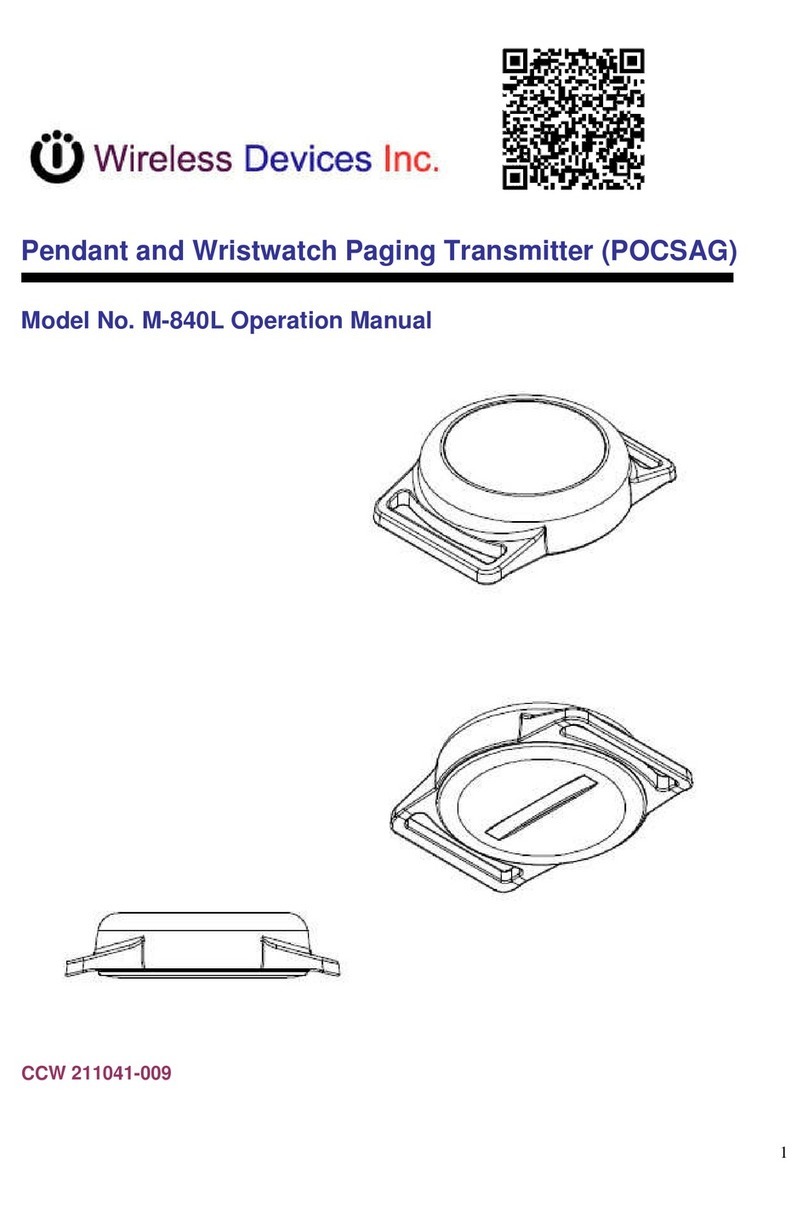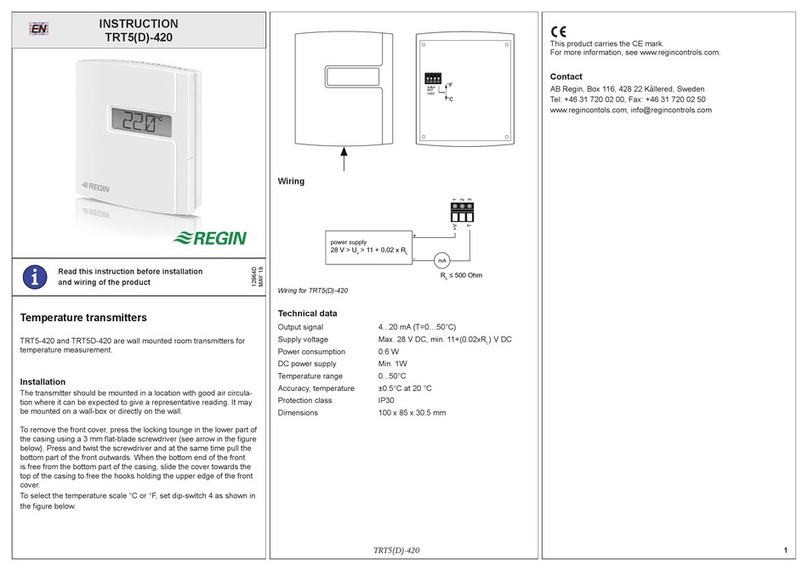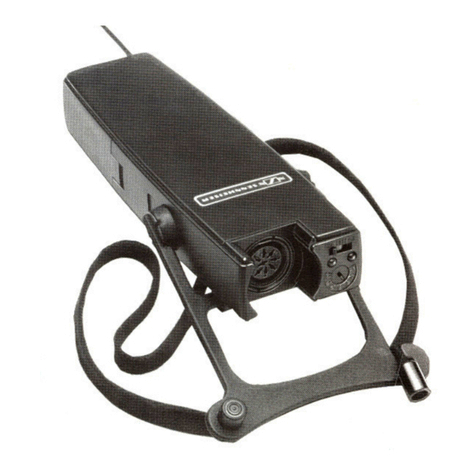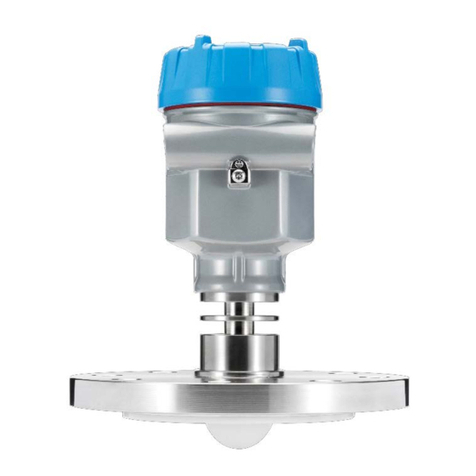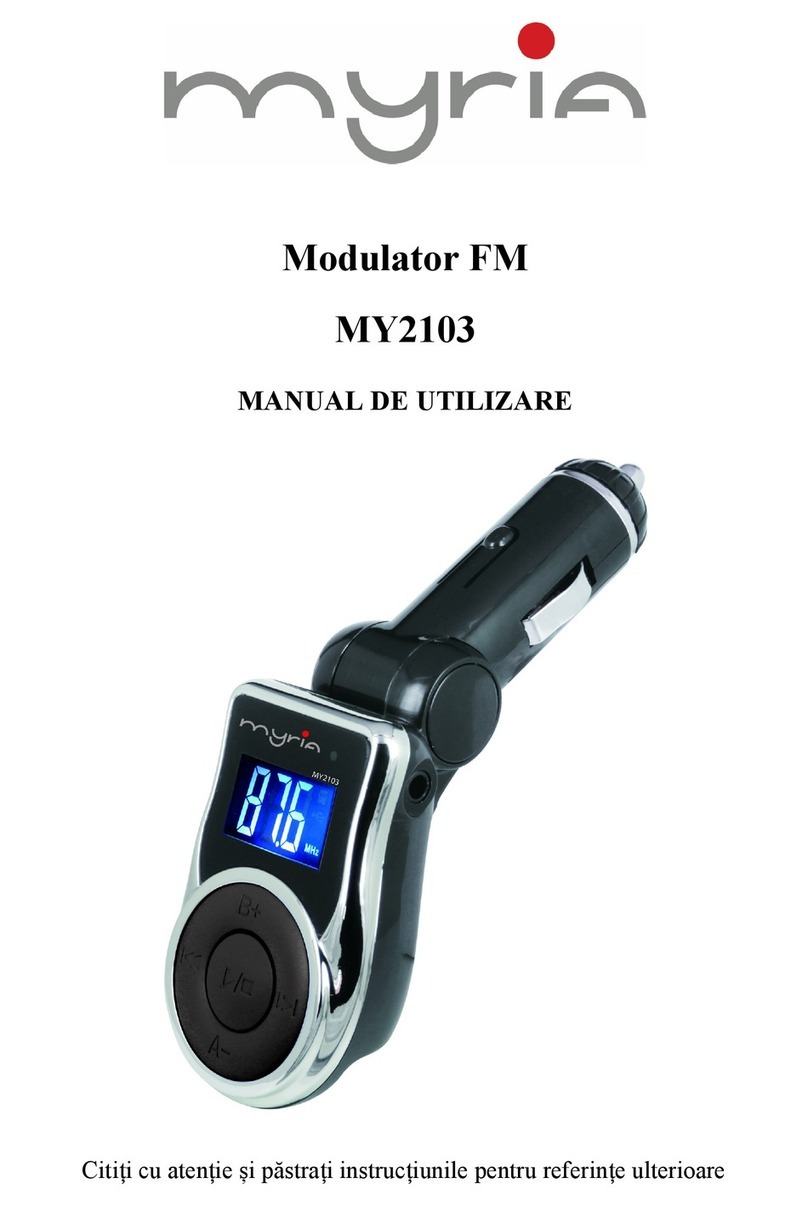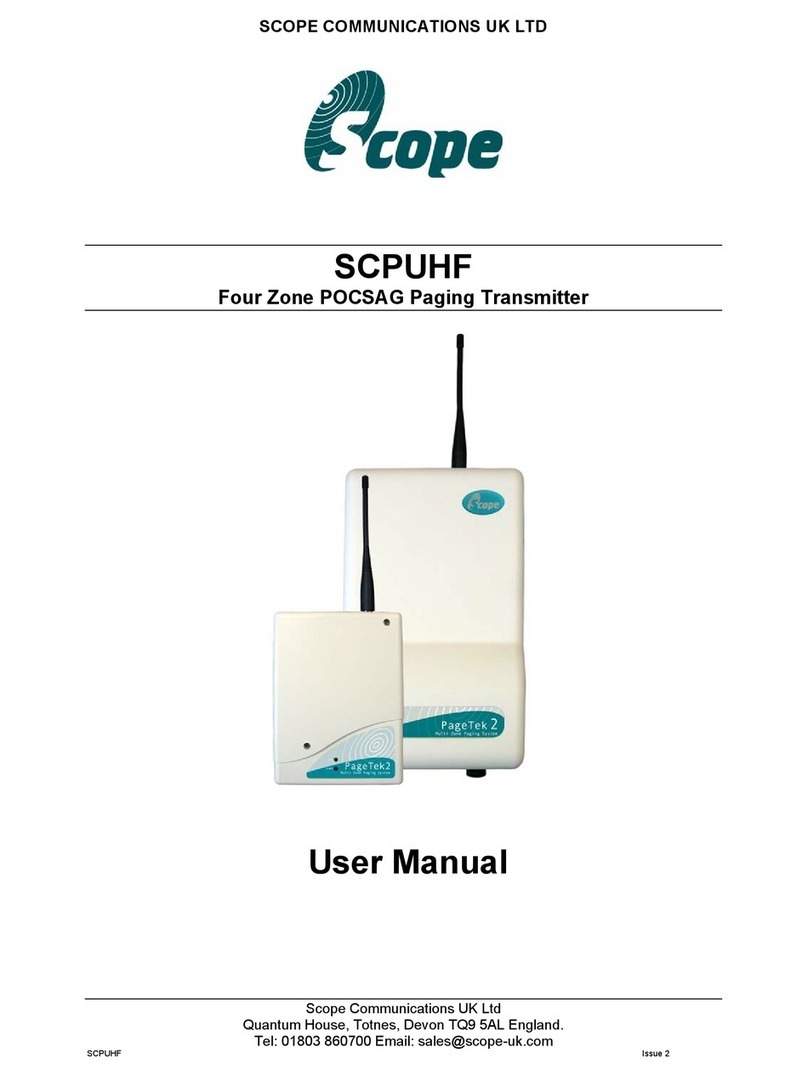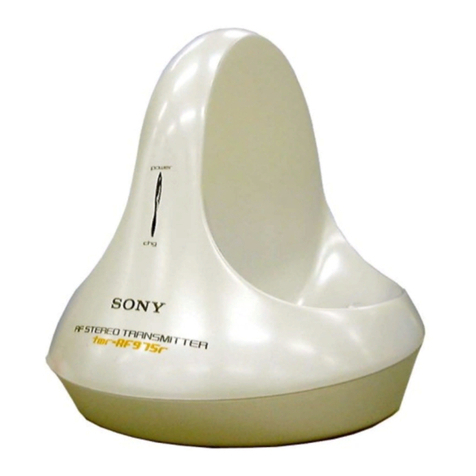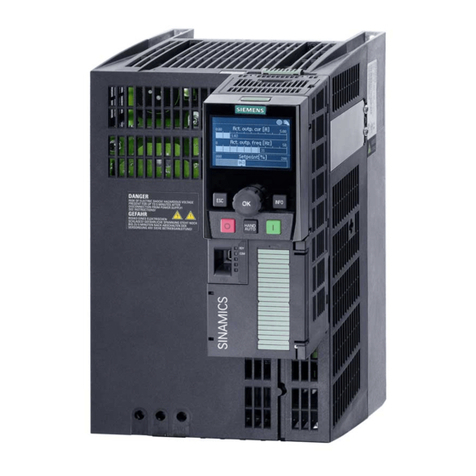Gonnheimer Elektronic D122.T User manual

User's manual
Set-point-
transmitter
D122.T
Edition of standards 2010, Software version 1.2.0

D122.T Manual Page 2
Table of Contents
1Operation instruction for Explosion protected device................................................................4
2Transmitter D122.T..........................................................................................................................5
2.1 Short description........................................................................................................................5
2.2 Features overview .....................................................................................................................5
2.3 Conformity with Standards.........................................................................................................6
3Installation and Connection...........................................................................................................6
3.1 D122.T with control panel housing ............................................................................................6
3.1.1 Installation control panel housing.......................................................................................6
3.1.2 Connecting D122.T with control panel housing..................................................................6
3.2 Field housing D122.T.................................................................................................................7
3.2.1 Connecting D122.T with field housing................................................................................7
3.3 Initial operation...........................................................................................................................8
3.3.1 Ex works settings – Device reset .......................................................................................8
4Operation manual............................................................................................................................9
4.1 Front view and push-keys..........................................................................................................9
4.2 Configuration............................................................................................................................10
4.3 Configuration example.............................................................................................................13
5Flow charts....................................................................................................................................16
6Annex .............................................................................................................................................19
6.1 Specifications...........................................................................................................................19
6.2 Type code................................................................................................................................19
6.3 Dimensions..............................................................................................................................20
6.4 Application example: connection plan.....................................................................................21
6.5 Material specification ...............................................................................................................21
6.6 Marking....................................................................................................................................21
6.7 Transport, Storing, Repairs und Disposal................................................................................22
6.8 Failure messages.....................................................................................................................22
6.9 List of Parameters....................................................................................................................22

D122.T Manual Page 3
The symbols WARNING, CAUTION, NOTE
This symbol warns of a serious hazard. Failure to observe this
warning may result in death or the destruction of property.
This symbol warns of a possible failure. Failure to observe this
caution may result in the total failure of the device or the system
or plant to which it is connected.
This symbol highlights important information.

D122.T Manual Page 4
1 Operation instruction for Explosion protected device
Application and Standards
This instruction manual applies to explosion-protected control panels of type of protection
types below. This apparatus is only to be used as defined and meets requirements of EN 60
079 particularly EN60 079-14 "electrical apparatus for potentiality explosive atmospheres".
Use this manual in hazardous locations, which are hazardous due to gases and vapours ac-
cording to the explosion group and temperature class as stipulated on the type label. When
installing and operating the explosion protected distribution and control panels you should ob-
serve the respective nationally valid regulations and requirements.
General Instructions
The device has to have a back-up fuse as stipulated. The mains connection must have a suf-
ficient short circuit current to ensure safe breaking of the fuse. To achieve an impeccable and
safety device operation, please take care for adept transportation, storage and mounting, as
well as accurate service and maintenance. Operation of this device should only be imple-
mented by authorised persons and in strict accordance with local safety standards.
The electrical data on the type label and if applicable, the "special conditions" of the test cer-
tificate Fehler! Unbekannter Name für Dokument-Eigenschaft.are to be observed.
For outdoor installation it is recommended to protect the explosion protected distribution and
control panel against direct climatic influence, e.g. with a protective roof. The maximum ambi-
ent temperature is 40°C, if not stipulated otherwise.
Intrinsically Safe Circuits
Erection instructions in the testing certificates of intrinsically safe apparatus are to be ob-
served. The electrical safety values stipulated on the type label must not be exceeded in the
intrinsically safe circuit. When interconnecting intrinsically safe circuits it is to be tested,
whether a voltage and/or current addition occurs. The intrinsic safety of interconnected circuits
is to be ensured. (EN 60079-14, section 12)
Safety Measures: to read and to comply
Work on electrical installations and apparatus in operation is generally forbidden in
hazardous locations, with the exception of intrinsically safe circuits. In special cases
work can be done on non-intrinsically safe circuits, on the condition that during the
duration of such work no explosive atmosphere exists. Only explosion protected
certified measuring instruments may be used to ensure that the apparatus is volt-
age-free. Grounding and short-circuiting may only be carried out, if there is no ex-
plosion hazard at the grounding or short circuit connection.
Danger of static charge!
Clean only with humid cloth!
Do not open when an explosive dust atmosphere is present!

D122.T 2 Set point transmitter D122.T Page 5
2 Transmitter D122.T
2.1 Short description
The purpose of the D122.T is to make set-point adjustments, like e.g. temperature, pressure
or revolution, inside the explosion endangered area to e.g. high level control units outside ex-
plosion endangered areas, via a 4/20 mA current circuit.
The scale span of the transmitter amounts 2000 digits. An additional power supply is not nec-
essary, because the D122.T is in loop like a transmitter into the circuit of a transmitter power
supply.
The indicated value corresponds with the real measured current in the control circuit - it is not
just a static display. So, the user has control of the transmitted set point. Push and hold the
current control button to indicate the physical current in dimension mA.
The D122.T has a configurable incremental set point- setting. The user sets a new set point
by pressing the arrow buttons to increment or decrement the desired set point. The incre-
mental set point- setting works first with an resolution of 1 digit and furthermore with an adjust
progression – so wide set point- adjustments can be done quickly.
Use an additional D122.A indicator to indicate the actual value of the feedback control system.
Therefore, a hazardous area located simple process visualisation of a feedback control sys-
tem.
2.2 Features overview
;Ex i- Set-point transmitter D122.T into 4 /20 mA control circuit
•Loop powered - easy use in hazardous area, no additional power supply necessary
•Connecting like common transmitters
;Display
•41/2-digit 7-Segment display, 2000 digits
•LC-Display 30 mm digit height
•Fast bargraph for trend observation, (41 segments, refresh 4 times per second)
;Housings
•Control panel housing, protection class up to IP 55 (HxWxD) 72x144x80 mm
•Field housing, protection class IP 65 (HxWxD) 133,5x138x64 mm
;Ergonomics
•µ-Processor technology for extensive configuration
•Scaled by keyboard and display, without reference current
•Separately scaleable bargraph (Zoom)
•Incremental set point setting (software version 1.1.0 and later)
•Current control button (not available by incremental set point setting)
•Keeps the configuration after turn off
•Ability to change configuration during operation
•Exchangeable dimension signs
;Service
•Customised calibration

D122.T 2 Set point transmitter D122.T Page 6
2.3 Conformity with Standards
The explosion proof indicators type D122.T meets requirements of listed standards in the attachment
(Declaration of conformity). They were developed, manufactured and tested in accordance with state-
of-the-art engineering practice and ISO9001:2008.
3 Installation and Connection
3.1 D122.T with control panel housing
3.1.1 Installation control panel housing
The D122.T.3 is predicated for installation in a control panel.
How to insert
the dimension
symbol
Insert the dimension symbol (icon) before mounting. Do this by first
removing the front frame as shown in the figure at left. Now remove
the front panel from the housing as shown in the figure on the right.
Cut the desired dimension symbol out of the set and pull it into its in-
tended place on the right side of the panel. Make sure that the symbol
is facing the front. Replace the front panel and frame.
How to fix the
device in the
control panel
Fix the device into the control panel with the intend cramps.
3.1.2 Connecting D122.T with control panel housing
Connect the indicator only to intrinsically safe
4..20 mA current circuits.
The terminals of the indicators in the control panel housing are
shown in figure Fehler! Verweisquelle konnte nicht gefunden
werden.. The terminals 5,6 and 7,8 are absent by indicators without
alarm monitoring.

D122.T 3 Installation and Connection Page 7
Please regard the terminal maximum values of the at-
tached EC- type certificate TÜV 99 ATEX 1488 .
Control panel
enclosure The terminals of the transmitter in the control panel housing are on the
backside.
Terminal Comment
1 + terminal 4 ..20 mA control circuit
Terminals
2 - terminal 4 ..20 mA control circuit
3.2 Field housing D122.T
Choose a solid place to install the transmitter in the field area.
How to insert
the dimension
symbol
First, cut the desired dimension symbol out of the set. Then pull off the
four screws of the cap and remove the cap from the housing.
Now push the prepared dimension symbol into the dimension symbol
slot. Make sure that the symbol is facing the front.
The dimension symbol slot are below the display, on the internal side
of the cap.
Finally replace the cup on the housing.
3.2.1 Connecting D122.T with field housing
Connect the indicator only to intrinsically safe
4..20 mA current circuits.
The terminals of the indicators in the control panel housing are shown
in figure Fehler! Verweisquelle konnte nicht gefunden werden..
The terminals 5,6 and 7,8 are absent by indicators without alarm moni-
toring.
Please regard the terminal maximum values of the at-
tached EC- type certificate TÜV 99 ATEX 1488 .
Field
housing
The terminals of the transmitter with field housing are inside.
Terminal Comment
1 + Terminal 4..20 mA control circuit
Terminals
2 - Terminal 4..20 mA control circuit

D122.T 3 Installation and Connection Page 8
3.3 Initial operation
After connecting, a display test (all segments of the display are on)
appears immediately during one second. Thereupon the display
shows the software version of the transmitter.
Default
parameters The following parameters are active ex works:
Scale (figure and bargraph)
•4 mA measured current -> 4.00
•20 mA measured current -> 20.00
Set point
•4 mA measured current -> 4.00
•Direct set point setting
Code words
•CODE1: 0001
•CODE2: 0002
3.3.1 Ex works settings – Device reset
Press the Enter- and Right-button during the start sequence to
reactivate the default parameters. (Hardware-Reset)
A reset activates also the ex works calibration.

D122.T 4 Operation manual Page 9
4 Operation manual
4.1 Front view and push-keys
;Front view
;Keys
On the front side of the transmitter are tree buttons with several function symbols. With these
tree buttons the user can activate each function and enter any parameters for any individual
setting.
Each button is named by its function:
Enter-button
Pressing the enter-button starts the input menu.
In general, the enter-button activates the menu item or accepts the manipu-
lated value of a parameter.
Up-button
Functions of the up-button are:
1. present current value button or increment set point
2. modification of the selected figure
3. pass menu items
Right-button
Functions of the right-button are:
1. change the state to set point edit menu or decrement set point
2. select figures
3. pass menu items

D122.T 4 Operation manual Page 10
4.2 Configuration
It is easy to set the parameters and change the configuration of the transmitter. The inputs
are logical grouped by a menu structure. The flow charts of these menus can be found at
chapter 5.
,Note Flow
charts
SET
The Input-views in the flow diagrams have additional
boxes in their background, because the Input-views may
be changed by pressing any button.
The procedure, to enter a value, is shown in the flow
chart ‘Edit menu’, see Figure 4: Flow chart edit mode
)Normal state
After connecting, the transmitter D122.T starts to initialise its
configuration. The configuration data is stored in an internal
EEPROM due to the previous run. On the first start, the
D122.T transmitter initialises the ex works configuration.
Directly past starting sequence the transmitter begins to
operate. This state is called the ‘normal state’ of the D122.T
and the transmitter is also ready for inputs.
(See also flow diagram in Figure 1)
)Set point
adjusting It is possible to adjust the set point in two ways:
1. Direct set point setting: the user pushes the right-
button following the enter-button. The D122.T is then in
the set point edit mode and the user can enter the new
set point by editing the figures of the set point.
2. Incremental set point setting: the transmitter is in
normal state. The user pushes the up-button to incre-
ment the set point or he pushes the right-button to dec-
rement the set point .
Configure the way of the set point adjustment in the input
menu of the D122.T (as shown below). The direct set point
setting is configured ex works.
,Tip* If the incremental set point setting is active – then the pre-
sent current control as well as the direct set point setting is
not available.
)Present-value
control*
Pushing and holding the up-button (present value control
button) the display shows the present measured value.
(See also flow diagram in Figure 1)

D122.T 4 Operation manual Page 11
)Direct set point
setting*
One touch on the right-button starts the preset menu.
(See also flow diagram in Figure 1: flow chart normal state)
SET SET
The transmitter screen shows “SET”.
Press the enter-button to see the present preset value.
Press the enter-button a second time, to change the preset
value.
The display switches into the
;Edit mode.
_1234 A blinking segment appears below the sign place. Pressing
the right-button selects the figures and the up-button incre-
ments the selected figure. To accept the new preset value,
press the enter-button.
(See also flow diagram in Figure 4)
;Code protection
CodE 2
Before the menu gets to the edit mode the code 2 must be
entered, to prevent a modification by unauthorised per-
sons. Entering a wrong code word stops the limit view
menu immediately.
The default code 2 is [0002].
The interrogation of code 2 can be switched off by modify-
ing the code 2 to [0000]. For this reason the flow diagram
shows the code interrogation in stroked dots. To change the
code you must enter the input menu, as shown below in this
chapter.
;Parameter
entering (See also flow diagram in Figure 2)
Back in the normal state of the transmitter we start the
)Input menu by pressing the enter-button.
CodE 1
The configuration of the transmitter is protected against ma-
nipulations by unauthorised persons with the code 1. To join the
input menu enter the code 1 .(Default: 0001).
It’s impossible to switch off the code 1 interrogation.

D122.T 4 Operation manual Page 12
After entering the right code word the transmitter proposes to join
the
SCAL Scale menu. The figure on the left hand appears on the display.
To scale the measured current, the bargraph and to set the
decimal point join the scale menu by confirming with the enter-
button.
(See also flow diagram in Figure 3).
Enter the upper scale point correct figured ‘as big as possible’
(the first figures should not be ‘0’)
In this case you get the maximum precision of the transmitter.
SET
Press the right-button to pass the scale menu and select the
second submenu, the preset menu. To join it, press the en-
ter-button.
(See also flow diagram in Figure 4)
roll This is the menu item to configure the way of the set point
setting.
Start with pressing the enter-button. Now toggle between
[roll n] (= roll – no i.e. direct set point setting) and [roll y] (=
roll – yes, i.e. incremental set point setting) by pressing any
arrow button.
Confirm the desired configuration by pressing the enter-
button.
CodE 1
CodE 2
The next two following items allow to manipulate the words
for code 1 and code 2. The enter-button confirms the input
and the corresponding code appears in edit mode.
Remember that the code word [0000] will switch off the code
2.
CAL
Finally it’s possible to calibrate the transmitter with the fol-
lowing submenu called calibration menu. Regard, the
transmitter is already calibrated ex-works.
In general, a further calibration is not necessary and
only experienced persons are allowed to calibrate it.
End
Now we reach the end of the input menu. Confirm all set-
tings with the enter-button. The transmitter switches back to
normal state.
If you want to repeat the input menu, press the right-button.

D122.T 4 Operation manual Page 13
If an invalid value is entered for any of the parameters, you
will not be able to quit the input menu. Instead, the menu
program switches automatically into edit mode to the identi-
fied invalid value.
4.3 Configuration example
For a successful parameter input, see the following example of a temperature transmitter.
This demonstration is based on the ex works settings (default parameters). If you had al-
ready made other settings reset the transmitter, as shown in chapter 3.3, Make a reset to the
device to get back the default parameters.
Situation Adjustment:
•Preset range:
-20,0°C ...+150,0°C
1] Measure range:
2] Bargraph:
3] Incremental set
point setting
-020,0 °C ... + 150,0°C
for 4 ... 20 mA
-020,0°C ... + 150,0°C
Procedure:
One touch on the enter-button quits the normal state and
starts the input menu.
CodE1
The menu interrogates for code 1.
The default code 1 is [0001].
Enter the right code word using the arrow buttons.
Finally hit the enter-button.
;Scaling display and barograph:
SCAL
Join the scale menu by pressing the enter-button.
dP.Pos
First set the position of the decimal point. The position of
the decimal point will be used for each parameter, like dis-
play, barograph and preset value.
Set the decimal position after the third position (counted
from left side), because we will enter [1500] for the high
scale point afterwards.
Choose the enter-button to edit the decimal point position
and push the right-button. Watch the display, the decimal
point shifts right.
Press the enter- button, to quit decimal point setting.

D122.T 4 Operation manual Page 14
SCA L
Now the [scale point low] view appears.
Edit by pressing the enter-button and enter the lower scale
point
[0200] (-20°C) as follows:
_040.0
- 040.0
Press the up- button to select the negative symbol.
Now press the right- button for two times to select the second
figure.
-040.0
...
Repeat pushing the up-button until ...
-020.0
... the figure 2 appears.
confirm the lower scale point by pushing the enter-button, so the
scal point high parameter (SCA H) will be displayed .
SCA H
According above, enter now the figure sequence [1500] to the set
the scal point high to 150°C.
(Confirm with the enter-button).
Enter the upper scale point correct figured ‘as big as possible’
(the first figures should not be ‘0’)
In this case you get the maximum precision of the transmitter.
It is not possible to set a preset range bigger than 2000 digits. The
device refuses a bigger range. But it is possible to place the pre-
set range of 2000 digits in the range of –9999 to +9999 (e.g. 6000
... 8000).
bAr L Now scale the bargraph. Hit the enter-button.
Enter [-0200] (-20 °C) for the lower bargraph scale point.
Confirm by hitting the enter-button.
bAr H
Enter [1500] (150°C) for the upper bargraph scale point.
Pushing enter-button accepts and quits the scale menu.
Pass the menu point [Set ] by pressing the right-button.
roll Now configure the incremental set point setting. First press the
enter-button. Then press the up-button to select [roll y].
Finally confirm by pushing the enter-button.

D122.T 4 Operation manual Page 15
We pass simply the following menu items (manipulate code
words and calibrate) using the right-button.
EnD
Finally quit the input menu hitting the enter-button.
The transmitter is back in normal state. The changes are immedi-
ately active and will still be active after power off (disconnecting
the transmitter).

D122.T 5 Flow charts Page 16
5 Flow charts
Figure 1: flow chart normal state (by direct set point setting only)

D122.T 5 Flow charts Page 17
Figure 2: Flow chart input menu

D122.T 5 Flow charts Page 18
select
low scale point
Scale
menu
END
Scale
menu
START
select
high scale point
SET SET
SET
select bargraph
high position edit bargraph
high position
edit bargraph
low position
select bargraph
low position
SET
SET
SET
SET
SET
edit low scale point
(4 mA measure cur.)
edit high cale point
(20 mA measure cur.)
set position
SET SET
select decimal
point position
Figure 3: Flow chart scale menu
Menu
END
sign is
selected
first figure
is modified
etc.
etc.
edit values -
enter code
Menu
END
Menu
END
first figure
is selected
Menu
END
Menu
END
Menu
END
Menu
END
etc.
e
t
c
.
etc.
Menu
END
e
t
c
.
Menu
END
SET
SET
SET
SET
SET
SET
SET
SET
SET
second figure
is selected
sign
is modified second figure
is modified
second figure
is modified
first figure
is modified
sign
is modified
Figure 4: Flow chart edit mode

D122.T 6 Annex Page 19
6 Annex
6.1 Specifications
D122.T
D122.T.3 D122.T.5 (7)
Display seven-segment LCD
Digit height 30 mm
Display range 4 1/2 figures, 2000 Digits
Dimension symbols Selectable by defined symbols
Decimal points Selectable by keyboard
Bargraph 41 segments, refresh 4 Hz
control circuit Intrinsically safe control circuit 4 ...20 mA,
Voltage range 8 ..30V; Voltage drop ca. 8V
Current control button Direct current indication in control circuit
control circuit limits No-load voltage UI= 65 V, short-circuit current II= 160 mA; PI= 1,6 W
Internal inductance: < 40 μH, Internal capacitance: < 10 nF,
see certificate PTB 99 ATEX 1488
Explosion protection E Ex ib IIC T6 at ambient temperature 45°C
or E Ex ib IIC T5 at ambient temperature 60°C
Housing Acc. to control-panel standard DIN
43700 -
Environment Protection Front panel IP 40 up to IP 55 IP 65
Dimensions HxWxD
[mm] 72 x 144 x 80 133,5 x 138 x 82
Control panel hole 66 x 136,5
Material glass fibre strengthened Noryl ABS
Measuring error 0,1% ±2 digits referring to measure range
Temperature
coefficient < 0,01% of measure range / K
Ambient
temperature limit -10°C ...+45°C at temperature class 6 or
-10°C ...+60°C at temperature class 5
devices for -20°C ambient temperature on inquiry
6.2 Type code Set-point transmitter D122.T .x
Housing:
Control panel housing.......................................................................
Field housing ...................................................................................
.3
.5

D122.T 6 Annex Page 20
6.3 Dimensions
Figure 5: Control panel housing, only the dimensions in brackets are valid
Figure 6: Field housing D122.T.5
M16 x 1,5
(total height)
Figure 7: Field housing D122.T.5
Table of contents
Popular Transmitter manuals by other brands

Sony
Sony WRT-808A Service manual
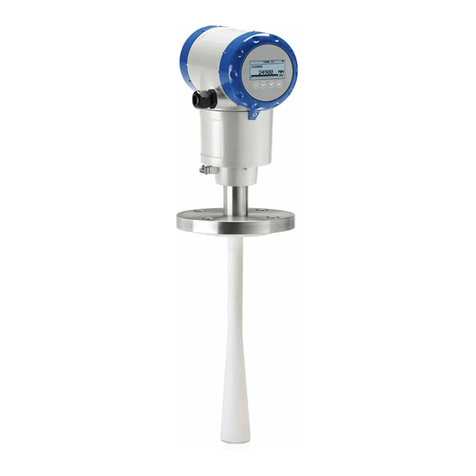
KROHNE
KROHNE OPTIWAVE 5200 C/F Supplementary instructions
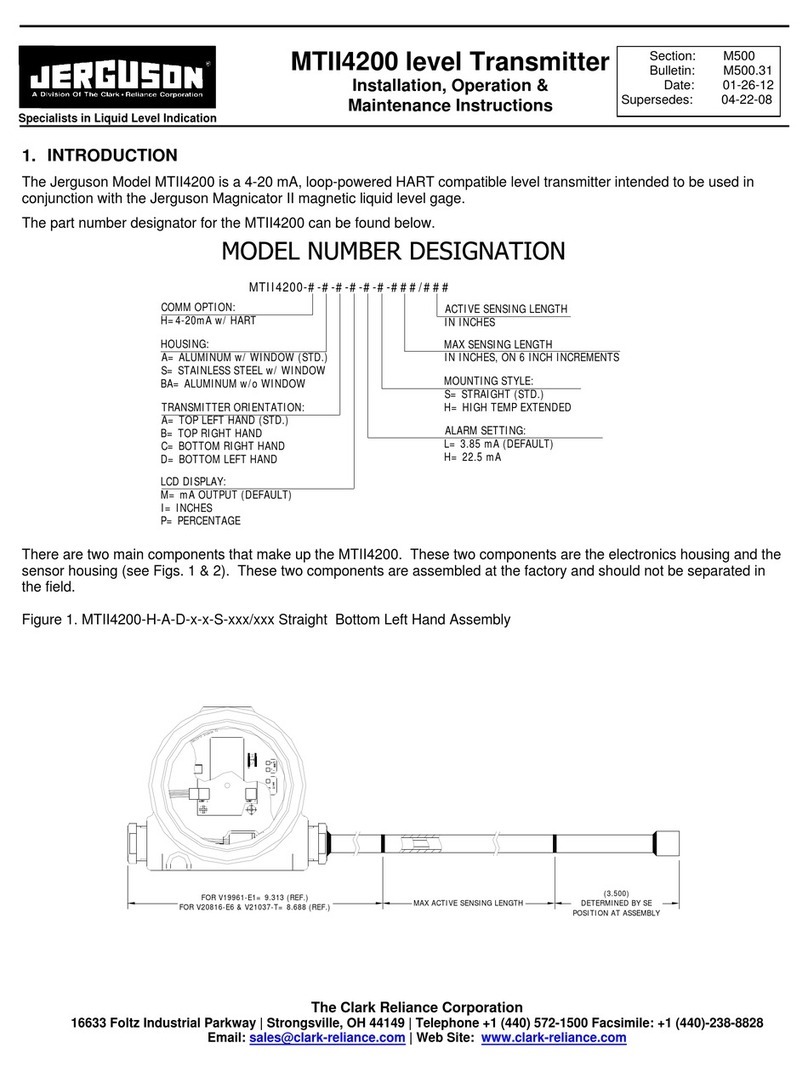
Jerguson
Jerguson MTII4200 Series Installation, operation & maintenance instructions
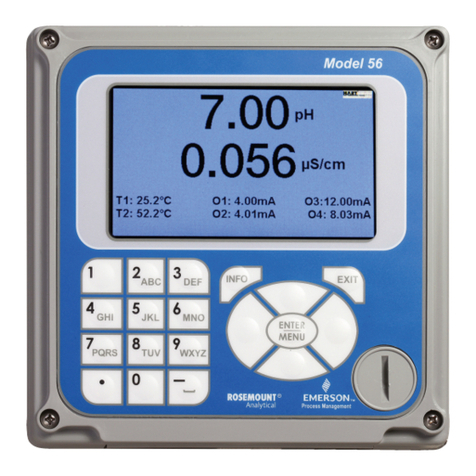
Emerson
Emerson Rosemount 56 quick start guide

Continental Refrigerator
Continental Refrigerator T2x user manual
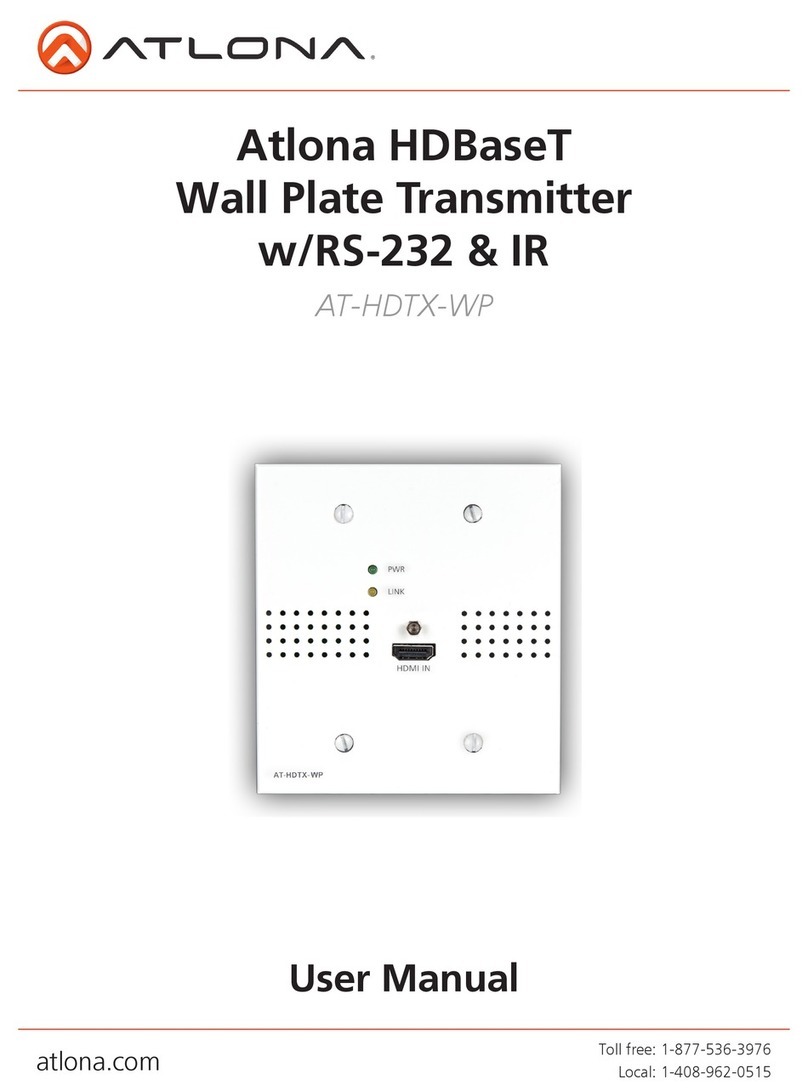
Atlona
Atlona AT-HDTX-WP user manual
